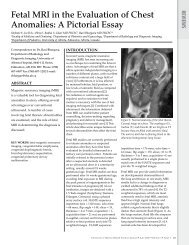Complete Issue PDF - University of Alberta Health Sciences Journal
Complete Issue PDF - University of Alberta Health Sciences Journal
Complete Issue PDF - University of Alberta Health Sciences Journal
- No tags were found...
Create successful ePaper yourself
Turn your PDF publications into a flip-book with our unique Google optimized e-Paper software.
REVIEWIn the event a patient demands a skinbiopsy, it may be worthwhile to do onerather than risk losing rapport with thepatient. Koo and Lee (2001) suggest makinga verbal agreement beforehand, and thatthe patient be more flexible in his or herthinking if the biopsy returns negative; thismay make it easier to convince the patientto take antipsychotic medications afterthe biopsy. 8 When antipsychotic therapyis initiated, it is advisable to <strong>of</strong>fer themedication as an empirical therapy whileemphasizing the potential for reductionin symptoms, like biting and crawlingsensations. 8 Potential side effects <strong>of</strong> theantipsychotics should be discussed withthe patient beforehand, to enhance patientcompliance. Considering the patient’s comorbiditieswhen selecting the particularantipsychotic to be used can help tailorthe choice; for example, in a patient withdiabetes, olanzapine should be avoideddue to its potential for metabolic syndromeside effects. Depot injections (risperidone)should only be pursued as an optionif the patient is willing to be regularlymonitored by a psychiatric team. Workingin conjunction with the patient’s familyphysician to monitor both the side effects <strong>of</strong>the antipsychotic medication and course <strong>of</strong>the DP will reduce the risks <strong>of</strong> complicationsfrom the therapy, especially if the patientrefuses the involvement <strong>of</strong> psychiatry.CONCLUSIONThere has never been a randomizedcontrol trial directly comparing atypicalantipsychotics to typical antipsychotics,which would be useful in establishing aclear treatment <strong>of</strong> choice for DP. 10 However,based on the efficacy <strong>of</strong> drugs in bothclasses as shown in Tables 1 and 2, it wouldappear that atypical antipsychotics have alower side effect pr<strong>of</strong>ile while achieving apartial to full remission rate similar to typicalantipsychotics. The reduction in adverseiatrogenic events would improve patientcompliance to treatment and help constructa therapeutic relationship between thepatient and physician.References:1. Wilson FC, Uslan DZ. Delusionalparasitosis. Mayo Clin Proc. 2004;79:1470.2. Wilson J, Miller H. Delusions <strong>of</strong> Parasitosis.Archives <strong>of</strong> Dermatology and Syphilology.1946;54:39-56.3. Boggild AK, Nicks BA, Yen L, VanVoorhis W, McMullen R, Buckner FS,et al. Delusional parasitosis: six-yearexperience with 23 consecutive cases at anacademic medical center. Int J Infect Dis.2010;14:e317-21.4. DSM-IV-TR. Diagnostic and statisticalmanual <strong>of</strong> mental health disorders (4thed, text revision). In. Washington DC:American Psychiatric Association, 2000.5. Huber M, Kirchler E, Karner M,Pycha R.Delusional parasitosis and the dopaminetransporter. A new insight <strong>of</strong> etiology? MedHypotheses. 2007;68:1351-8.6. Donabedian H. Delusions <strong>of</strong> Parasitosis.Clin Infect Dis. 2007;45:e131-4.7. Driscoll MS, Rothe MJ, Grant-KelsJM, Hale MS. Delusional parasitosis:a dermatologic, psychiatric, andpharmacologic approach. J Am AcadDermatol. 1993; 29:1023-33.8. Koo J, Lee CS. Delusions <strong>of</strong> parasitosis.A dermatologist’s guide to diagnosis andtreatment. Am J Clin Dermatol. 2001;2:285-90.9. Robles DT, Romm S, Combs H, OlsonJ, Kirby P. Delusional disorders indermatology: a brief review. DermatolOnline J. 2008;14:2.10. Lepping P, Russell I, Freudenmann RW.Antipsychotic treatment <strong>of</strong> primarydelusional parasitosis: systematic review. BrJ Psychiatry. 2007;191:198-205.11. Lorenzo CR, Koo J. Pimozide indermatologic practice: a comprehensivereview. Am J Clin Dermatol. 2004;5:339-49.12. Elmer KB, George RM, Peterson K.Therapeutic update: use <strong>of</strong> risperidonefor the treatment <strong>of</strong> monosymptomatichypochondriacal psychosis. J Am AcadDermatol. 2000;43:683-6.13. Ungvari G, Vladar K. Pimozide treatmentfor delusion <strong>of</strong> infestation. Act Nerv Super(Praha). 1986;28:103-7.14. Opler LA, Feinberg SS. The role <strong>of</strong>pimozide in clinical psychiatry: a review. JClin Psychiatry. 1991;52:221-33.15. Hamann K, Avnstorp C. Delusions <strong>of</strong>infestation treated by pimozide: a doubleblindcrossover clinical study. Acta DermVenereol. 1982;62:55-8.16. Zomer SF, De Wit RF, Van Bronswijk JE,Nabarro G,Van Vloten WA. Delusions <strong>of</strong>parasitosis. A psychiatric disorder to betreated by dermatologists? An analysis <strong>of</strong>33 patients. Br J Dermatol. 1998;138:1030-2.17. Lyell A. The Michelson Lecture. Delusions<strong>of</strong> parasitosis. Br J Dermatol. 1983;108:485-99.18. Bhatia MS, Jagawat T, Choudhary S.Delusional parasitosis: a clinical pr<strong>of</strong>ile. IntJ Psychiatry Med. 2000;30:83-91.19. Lindskov R, Baadsgaard O. Delusions <strong>of</strong>infestation treated with pimozide: a followupstudy. Acta Derm Venereol. 1985;65:267-70.20. Meltzer HY. What’s atypical about atypicalantipsychotic drugs? Curr Opin Pharmacol.2004;4:53-7.21. Kapur S, Remington G. DopamineD(2) receptors and their role in atypicalantipsychotic action: still necessary andmay even be sufficient. Biol Psychiatry.2001;50:873-83.22. Westerink BH. Can antipsychotic drugs beclassified by their effects on a particulargroup <strong>of</strong> dopamine neurons in the brain?Eur J Pharmacol. 2002;455:1-18.23. Gallucci G, Beard G. Risperidone andthe treatment <strong>of</strong> delusions <strong>of</strong> parasitosisin an elderly patient. Psychosomatics.1995;36:578-80.24. De Leon OA, Furmaga KM, CanterburyAL, Bailey LG. Risperidone in thetreatment <strong>of</strong> delusions <strong>of</strong> infestation. Int JPsychiatry Med. 1997;27:403-9.25. Healy R, Taylor R, Dhoat S, LeschynskaE, Bewley AP. Management <strong>of</strong> patientswith delusional parasitosis in a jointdermatology/ liaison psychiatry clinic. Br JDermatol. 2009; 161:197-9.26. Kenchaiah BK, Kumar S, Tharyan P.Atypical anti-psychotics in DelusionalParasitosis: a retrospective case series <strong>of</strong> 20patients. Int J Dermatol. 2010; 45:95-100.27. Wenning MT, Davy LE, Catalano G,Catalano MC. Atypical antipsychotics inthe treatment <strong>of</strong> delusional parasitosis.Ann Clin Psychiatry. 2003;15:233-9.28. Nicolato R, Correa H, Romano-Silva MA,Teixeira AL, Jr. Delusional parasitosis orEkbom syndrome: a case series. Gen HospPsychiatry. 2006;28:85-7.29. Shah A, Pervez M. Risperidone LongActing Injection (RLAI) in DelusionalParasitosis. German <strong>Journal</strong> <strong>of</strong> Psychiatry.2009;12:35-7.30. Rocha FL,Hara C. Aripiprazole indelusional parasitosis: Case report. ProgNeuropsychopharmacol Biol Psychiatry.2007;31:784-6.31. Bennassar A, Guilabert A, Alsina M, PintorL,Mascaro JM, Jr. Treatment <strong>of</strong> delusionalparasitosis with aripiprazole. ArchDermatol. 2009;145:500-1.32. Sandoz A, LoPiccolo M, Kusnir D, TauskFA. A clinical paradigm <strong>of</strong> delusions<strong>of</strong> parasitosis. J Am Acad Dermatol.2008;59:698-704.33. Freudenmann RW, Kuhnlein P, LeppingP,Schonfeldt-Lecuona C. Secondarydelusional parasitosis treated withpaliperidone. Clin Exp Dermatol.2009;34:375-7.34. Freudenmann RW, Lepping P. Secondgenerationantipsychotics in primary andsecondary delusional parasitosis: outcomeand efficacy. J Clin Psychopharmacol.2008;2:500-8.12<strong>University</strong> <strong>of</strong> <strong>Alberta</strong> <strong>Health</strong> <strong>Sciences</strong> <strong>Journal</strong> • April 2012 • Volume 7 • <strong>Issue</strong> 1






